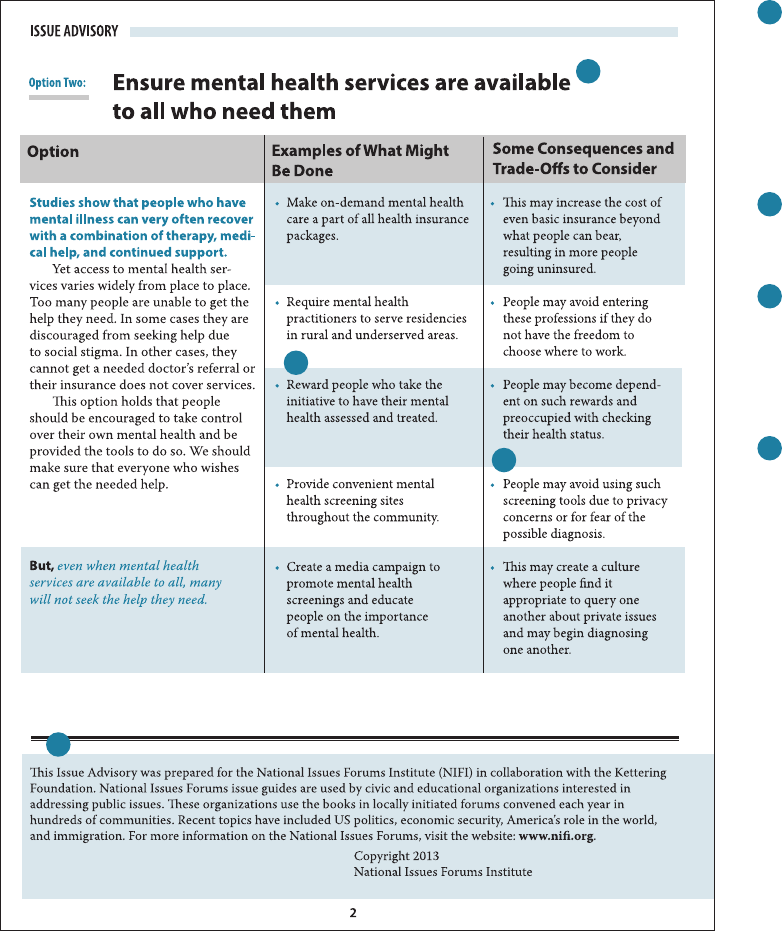
Developing Materials
for Deliberative Forums
Brad Rourke

1 Introduction
3 Naming and Framing Issues in Public Terms
5 A Way to Do It
5 Essential Elements
6 e Framing Team
7 e Topic
Problems Suited to Public Deliberation
10 Background Research
Gathering Public Concerns
Grouping Like Concerns
Values and ings Held Valuable
20 Describing the Options
22 Testing the Framework
Deliberative Framework Checkpoints
25 Writing the Issue Guide
Voice and Language
Sources
27 Conclusion
28 Appendix: Example Issue Framework

Introduction
Democracies face many challenges. Some of these are particular to
democracies—that is, societies in which the public is the ultimate
political authority. ese are the problems of democracy, or problems
that get in the way of the proper functioning of self-rule.
Here are three important problems of democracy:
Citizens play an increasingly narrow role in public life. They
may have been shut out of politics; they may have sidelined
themselves. Or both. This is a problem for any democracy, which
depends on citizen participation for its legitimacy.
Even if they step forward and take their place in public life,
citizens may find it difficult to make sound decisions together.
They react hastily, or act only in self-interest without considering
broader perspectives.
Even if citizens make sound decisions together about the issues
facing them, they may find it difficult to act together to move
forward. Citizens often do not have the habit of working with one
another in the public realm.
e Kettering Foundation, a research organization that studies what
it takes for democracy to work as it should, has examined public
practices of politics for more than 30 years. Our research suggests
that, when issues are named and framed in ways that are rooted in
what people hold deeply valuable, citizens are more likely to work
together in addressing shared problems. Deliberating together, people
work through disagreements, make sound choices, and reclaim their
voice as citizens.
Deliberation is a word for the careful weighing of options against the
things we hold valuable in order to make decisions. When citizens
deliberate together about important issues, they can reach decisions
and take action together on problems that confront them. People
deliberate together over problems in many settings—at home, in
coee shops, at public meetings, and in forums. Deliberation is not
a specialized process—people do it naturally. (For a more detailed
exploration of naming and framing, see the Kettering publication
Naming and Framing Dicult Issues to Make Sound Decisions.)
Deliberation does not require a certain kind of guide, or framework,
1 DEVELOPING MATERIALS FOR DELIBERATIVE FORUMS

2 DEVELOPING MATERIALS FOR DELIBERATIVE FORUMS
or language, or facilitator. But, because it can be dicult to face such
choices, supporting materials can make it easier. Many community
groups, national organizations, and others, including the National
Issues Forums (NIF), develop materials meant to help groups
deliberate together over dicult public issues. rough its research,
the Kettering Foundation has learned about the kinds of materials that
can spark this public work. is document explores the important
elements involved in going from an initial topic to having a complete
issue guide suitable to use in the kinds of deliberative forums that
are the hallmark of the NIF.
Deliberative forums are used in dierent ways, depending on the
community and who is involved. Some communities use them to set
direction on important local issues. People in other communities
may hold forums in order to give citizens the opportunity to think
through an important national issue and what they and others might
do about it. e results of deliberating together in these ways are
sometimes passed on to public ocials. Other times public ocials
personally take part in deliberating with other citizens.
ere are many ways to create materials that will support such public
deliberation. As long as they are accessible to all kinds of people,
allow them to carefully consider options and weigh drawbacks, no
one way is necessarily better than another.
This document explores the
important elements involved
in going from an initial topic
to having a complete issue
guide suitable to use in
the kinds of deliberative
forums that are the hallmark
of the NIF.

Naming and Framing Issues
in Public Terms
When issues are named and framed in public terms, we can
identify the problem that we need to talk about (naming) and the
critical options and drawbacks for deciding what to do about that
problem (framing).
When citizens see their concerns reected in the naming and framing
of an issue, they are more likely to participate in making decisions
and to see that they themselves have power to aect their future. is
goes beyond simply using clear language (this is part of it, but not the
only aspect). It means that the problem must be stated in terms that
take into account the things that people hold deeply valuable. is is
the essence of naming problems in public terms.
A framework that will prompt public deliberation should make clear
the options that are available for addressing the problem and the ten-
sions at stake in facing it. It should lay bare what is at issue in readily
understandable terms.
Three key questions drive the development of a framework
for public deliberation:
What concerns you about this issue?
Given those concerns, what would you do about it?
If that worked to ease your concern, what are the downsides
or trade-offs you might then have to accept?
Responses to these questions, together, can generate a framework
that makes clear the drawbacks of dierent people’s favored options.
Facing these drawbacks and coming to a sound decision about what
to do is the ultimate concern of deliberation.
Issue framing is a practice, not a process or specic technique—akin
to playing a musical instrument, knitting, martial arts, or exercising.
e best way to learn about these things is by doing them. e more
people work at the practice of issue framing, the better they get at
A framework that will
prompt public deliberation
should make clear the
options that are available
for addressing the problem
and the tensions at stake
in facing it. It should lay bare
what is at issue in readily
understandable terms.
3 DEVELOPING MATERIALS FOR DELIBERATIVE FORUMS
4 DEVELOPING MATERIALS FOR DELIBERATIVE FORUMS
identifying core concerns and articulating trade-os. Like any prac-
tice, this develops over time.
In deliberating together, people wrestle with options, face trade-os,
and make decisions about how to act. Sometimes people and orga-
nizations in communities convene deliberative forums where people
come together to do this work—NIF groups have been doing this
for 30 years. An issue framework, or issue guide, is intended to
support this. ere is no perfect issue framework. Any framework
that includes the public’s main concerns fairly represented and that
includes the important drawbacks of each option can provide the
structure for a group of people to deliberate together about how they
will address a shared problem.

5 DEVELOPING MATERIALS FOR DELIBERATIVE FORUMS
A Way to Do It
In developing materials to support public deliberation, writing an
issue guide is just the tip of the iceberg. e earlier work that goes
into naming and framing the issue—work that requires time and
people—is most important. e sections that follow describe one
way of naming and framing issues for public deliberation. e aim is
to create an issue guide that will be used by many kinds of people in
deliberative public forums. is is not the only way to achieve that
goal, but it is one that has worked well over time.
Essential Elements
An issue guide should introduce and support deliberation, collec-
tively, among a group whose individual experiences and inclinations
may dier.
e Appendix includes an annotated example of an issue framework:
Mental Illness in America: How Do We Address a Growing Problem?
is example was developed by following the principles outlined in
this document.
A well-framed issue guide contains enough factual material and data
so that citizens from dierent circumstances who deliberate together
have the knowledge they need to engage productively. However, it
doesn’t need to serve as a primer or study guide. Its purpose is not to
create experts but rather to illuminate what is at issue—the important
conicts or dilemmas that the issue raises—and allow people to make
decisions about how to act together.
Regardless of length, issue guides usually contain ve elements:
A title that reects the major tension inherent in the issue. e
title must convey that there is a dicult question or problem that
must be faced and can’t be ducked. An excellent title that starkly
conveys one problem at the core of the health-care issue might
be: “e High Cost of Good Health Care.”
A well-framed issue guide
contains enough factual
material and data so that
citizens who deliberate
together have the knowledge
they need to engage
productively. Its purpose is
not to create experts but
rather to illuminate what
is at issue and allow people
to make decisions about
how to act together.

6 DEVELOPING MATERIALS FOR DELIBERATIVE FORUMS
An introduction that explains what the issue is and why something
must be done about it. e introduction should make the case
that this is an important issue to talk about and should refrain
from “arguing” for any of the options.
Descriptions of each option for dealing with the issue. Each option
is an overall strategy that is driven by a unique concern when
it comes to the problem. ese sections are at their best when
they adopt a tone that argues for each specic option—that is,
each one should be persuasive and an argument against the
others. It should make its own strongest case. ese options each
have subsections.
e rst subsection includes examples of actions that would
correspond to each option, along with who would do them. e
actors should be real—and varied—such as government, police,
schools, or neighbors. We have found that identifying four or
ve actions per option helps give people a clear sense of what the
option is about and what people can do to work on solutions.
e second subsection includes examples of the drawbacks or
trade-os inherent in each action. Every action that is presented
should have an inherent drawback. Some may nd a drawback
tolerable, and others may not; however, talking through the con-
sequences of a particular action against what you hold valuable
is the crux of deliberation. e key is to make these choices clear.
Many participants will read the guide for the rst time during the
forum, so presenting data and facts as charts or other easily grasped
formats makes it easier to use. In many issue guides, the options are
summarized in the form of a grid, which provides the basic frame-
work at a glance.
The Framing Team
When it comes to the practice of issue framing and issue guide writing,
Kettering’s experience is that having multiple participants is crucial. e
best issue guides arise out of teamwork among a small group of people.
Developing an issue guide that provokes deliberation is iterative. It takes
place in ts and starts. Rooting the issue guide in public concerns and

7 DEVELOPING MATERIALS FOR DELIBERATIVE FORUMS
things held valuable takes a commitment to discerning and uncovering
those concerns. Bringing dierent perspectives to the table is important
if the resulting issue guide is to be useful to all kinds of people.
The framing team can include people who play a variety of roles:
Someone who can write clearly and evenhandedly, constructing
a good argument and avoiding jargon
Someone who can substantively research the problem at hand
Someone knowledgeable about public opinion, its use, and its
limitations
Someone in touch with community perspectives
Someone who has experience in framing issues for public
deliberation
e framing team develops the framework together, reviews the results
of tests, and responds to dras. is work is best done in conversa-
tion—face to face is oen best, but telephone calls work, too. It is
tempting, for the sake of convenience, to work primarily in e-mail
and to limit time-consuming conference calls and meetings. is can
be a mistake. Discussion better enables the group to grapple with
issue concerns and tensions that arise spontaneously in conversation.
e conversational aspect is important. It creates the environment
through which the team will generate new knowledge together.
Without such a team, without enough time together in conversation
to raise new ideas and generate breakthroughs, the resulting issue
guides are oen awed—meaning they derail or stymie deliberation.
Having multiple voices involved in substantive and ongoing ways
helps ensure that something is not overlooked, that all perspectives are
included, and that the result is fair to all.
The Topic
Public deliberation is useful when there is a public choice to be made
about a shared problem. What should we do?
Some problems lend themselves to deliberation better than others.
Some, though, are simply not suitable for public deliberation.
The framing team develops
the framework together,
reviews the results of tests,
and responds to drafts.
This work is best done in
conversation.

8 DEVELOPING MATERIALS FOR DELIBERATIVE FORUMS
For instance, many problems that communities face are technical in
nature. How large should the dam be? How wide should the bridge
be? How do we plow snow most eciently? ese are the kinds
of problems that it is oen best to ask experts to address. ey can
tell us the right answer and then political leaders can drive the
appropriate solutions.
Other problems are educational in nature. Some people don’t know
that they shouldn’t park on certain streets in snowy weather and
plowing operations get fouled up. Other people are not aware of the
services available to them as low-income residents, so they do with-
out things they need. ese kinds of problems can also be solved
in straight forward ways by getting more information out to the right
people (not to say they are easy to solve, just straightforward).
ese kinds of problems are not well-suited to public deliberation.
ere is no choice to be made by the public, nor work for it to do.
en there are the kinds of problems that require public decisions
leading to public actions. ese are oen problems that beset
communities over and over or are ongoing, systemic problems
that are dicult to solve. Persistent poverty is one such problem.
So is persistent crime. “What should we do about health care as
a community (or nation)?” is this kind of problem. ese problems
aect us collectively as well as personally.
ese problems are intractable because they involve tensions between
things held valuable, every solution has a downside, and there is no
denitive right answer. In many cases, there is lack of agreement about
what is even at issue, and when people try to nd solutions there are
conicts between things they hold valuable. And these problems can’t be
solved by experts or government alone—everyone needs to play a part.
Keeping in mind the characteristics of problems suited to deliberation
can make it easier to clarify the topic to deliberate over.
For instance, what we should do about the possibility of terrorism
in the United States is an example of a problem that might benet
from public deliberation. It appears intractable. We don’t agree on the
cause—is it radical Islamist politics, is it porous borders, is it oppression
by developed nations? Or is the cause something else? Similarly, there is
no denitively right solution—will jailing or deporting all potential ter-
rorists do the trick, or perhaps educating people around the globe about
These problems are
intractable because they
involve tensions between
things held valuable, every
solution has a downside,
and there is no definitive
right answer.

9 DEVELOPING MATERIALS FOR DELIBERATIVE FORUMS
the freedoms America represents? Every solution has trade-os—for
example, if we drastically restrict air travel, that may be eective but at
the cost of curtailing our fundamental freedom of movement. Finally,
any solution will require multiple actors—government alone can’t get
it done, nor can watchful individuals.
We need to solve and re-solve these kinds of problems, precisely
because we have to restrike a deal with one another each time we face
the problem. In 2001, aer terrorists struck the World Trade build-
ings, many people were willing to live with sudden dramatic travel
restrictions in pursuit of security. Today, the public’s willingness to go
along with that arrangement may not be as wholehearted.
is is not an educational question, but a political question. We
must decide together what we should do and what agreements we
will reach. e problems of this sort that we solve today will be
back later—not because we did a bad job solving them, but because
circumstances change.
A Problem Is Suited to Public Deliberation When...
The issue is of broad concern to the community
There is a decision that must be made about the issue
There is lack of agreement about what is at issue
There is disagreement on the cause of the problem, or the
cause is not clear
There is no definitive or single solution to the problem, but a
decision needs to be made about what may be done
Every solution involves trade-offs or downsides that involve
things held valuable
The problem is intractable, ongoing, or systemic
People will face moral disagreements in deliberating on the issue
Any solution will take multiple actors (e.g., community groups,
individuals, and government)

10 DEVELOPING MATERIALS FOR DELIBERATIVE FORUMS
Even keeping these points in mind, in the early stages of developing
an issue guide, the best that a framing team can do is to agree on a
general topic area—“poverty,” “crime in the community,” “the cost of
health care,” and so forth. is is ne. An initial topic can be a starting
point. e research into this topic, and the ensuing conversations,
will hone the topic (which is general) into an issue (which is specic).
Background Research
For many working on issue framing and developing materials to sup-
port deliberation, research can seem a daunting task. Most contentious
problems involve so many facts—how can they be synthesized into a
small space? Don’t get lost in the weeds. e key is to remember the
purpose of the materials, which is to generate public deliberation. e
materials do not have to serve as an in-depth study of the topic; they
simply have to provide the information necessary for people to struggle
with the trade-os inherent in the issue—the strategic facts.
A large portion of your research will not wind up in the text of your
issue guide in all of its minute detail. But amassing this background
material isn’t a wasted eort because it will lend condence to your
writing and will help you make your own wise choices in organizing
your research and deciding what to include in the nal written version.
Most issue guides begin with “desk” research. is kind of research
is straightforward. Someone—the writer of the guide or a researcher
tasked for this purpose—needs to gather the strategic facts about the
issue. Some framing teams divide up this task, each taking on a piece.
Others delegate it to someone who enjoys research.
This overview should include:
Main arguments being made about what to do about the issue
and what seem to be conflicting attitudes toward it (editorials and
op-ed pages are a good source)
Scan of recent public opinion reports about the issue (Gallup,
Public Agenda, and other survey organizations are useful)
Important historical and contemporary data points needed to
understand the issue
Interviews with experts, if appropriate

11 DEVELOPING MATERIALS FOR DELIBERATIVE FORUMS
As you gather the research, make sure to take note of compelling
graphics or charts that might enable you to represent an array of ideas
that could be reproduced in the nal version of the issue guide. And
always remember to ag particularly compelling anecdotes or quotes
that will help lend a conversational quality to your writing.
e purpose of this research is to develop an understanding of the
strategic facts about the issue at hand—those pieces of information
that bear on the decisions that citizens must make—and the way the
issue has been framed in the past.
For example, in research for an issue guide on the national debt, one
important strategic fact relates to the sheer size of the problem. Many
solutions are suggested—among them, eliminating certain govern-
ment departments. Some of these ideas sound promising until a
sense of scale is included, as this passage from the issue guide illus-
trates: “Even if we completely eliminate the federal departments of
Education, Energy, Agriculture, Transportation, Health and Human
Services, and Housing and Urban Development, we would save less
than $300 billion, but the annual decit is about $1.1 trillion.” Citizens
need to know this in order to make choices about how to tackle the
debt. On the other hand, deeper detail (such as the size of each par-
ticular department) is less decisive in nature. is is also the kind of
strategic fact that may well lend itself to a chart—a pie chart, in this case,
showing the small “slice of the pie” that such a change would represent.
Gathering Public Concerns
If the materials are to support public deliberation, they must begin
where the public does. Most contentious issues are framed in expert
terms by political and technical elites. People nd such framings
alien if they do not fully take into account citizens’ various starting
points and chief concerns. People will not have one starting point,
but many. e key is to capture them fairly and take them seriously.
e importance of this gap between expert views and the public’s view
of an issue is dicult to appreciate until it has been seen a few times.
It is easy to fall in line with the expert view—this is the one that typi-
cally dominates the public discourse. Only in talking with nonexperts,
without preconceptions, do we see how dierently citizens approach
an issue. Many groups that seek to develop issue guides balk at this
step because it involves some work many are unaccustomed to. Yet
skipping this may result in an ineective issue guide.
If the materials are to
support public deliberation,
they must begin where the
public does. There are many
ways to gather the public’s
concerns on an issue, and
they all involve actually
talking to people.

12 DEVELOPING MATERIALS FOR DELIBERATIVE FORUMS
ere are many ways to gather the public’s concerns on an issue, and
they all involve actually talking to people. In some cases, formal focus
groups are used, where the recruiting and convening functions are
handled in a professional facility where circumstances can be easily
controlled. A professional researcher leads such focus groups, and
transcripts and video are produced for later reference.
Yet some use a more community-based approach, where members
of the framing team go into the community and talk to friends,
neighbors, colleagues, and others. Team members talk to a number
of people, some manageable number between 5 and 15 people each.
Talking to people informally in groups tends to work well. Such
“concern-gathering sessions” can yield more than individual inter-
views, because people can hear what others are saying and respond
with their own ideas.
In these conversations, team members can ask things like:
When you think about [this topic], what concerns you? What
bothers you most, personally?
What concerns do you hear friends and family members—or others
you don’t know well—talking about when it comes to this topic?
Team members write down what they hear in these interviews—it
helps to take notes verbatim if possible. Capture the language people
actually use.
Note that, at this stage, interviews are on the topic in general—
there is not yet a name for the issue (in the sense discussed earlier).
Framing team members may in fact have a sense of what they believe
a reasonable question to deliberate over might be, but the name of
the issue emerges from these interviews and the analyses that follow.
Using a placeholder name for the issue can make it easier to talk about.
However, the process of concern gathering (and, later, grouping the
concerns) will rene the placeholder.
For example, a team may choose to ask people to talk about what
concerns them when it comes to education. e team may have in
mind that it will be developing materials to support deliberation on a
more narrow issue such as how best to ensure all young people have an
equal chance to succeed academically. By keeping the topic broad at
13 DEVELOPING MATERIALS FOR DELIBERATIVE FORUMS
this stage, the team will likely elicit more productive responses from
people it talks to.
Naming the issue is an iterative process. In this preparatory research,
concerns are being revealed so that options for action may be framed for
public deliberation.
Once the interviews are complete, the framing team should meet
together to discuss what it heard as well as other research it has done.
Be specic; stick to what people said. One person can be designated as
the facilitator or leader while another member of the team records what
is said. Flip chart paper works well, so everyone can see the responses.
In addition to simply reporting what they heard others say, the framing
team members should also report their own concerns in the same
setting, essentially answering the same questions. is should continue
until it appears that the list of concerns has been just about exhausted.
e facilitator can keep pressing participants to come up with more
concerns. It’s important to try to cast as wide a net as possible and to
keep at it even when it feels as if the reservoir is dry.
is, of course, limits the concerns to those expressed by team mem-
bers and interviewees. For this reason, try to have as much diversity
as possible in terms of who gets interviewed as well as who is on the
framing team. However, it isn’t always possible to achieve the kind of
cross-section that might be desirable. erefore, once it seems that all
the concerns have been aired, push ahead and ask specically about
those not in the room—how might they answer these same questions?
Imagine specic kinds of people (the elderly, new immigrants, the
poor, for example), and imagine what they actually might say.
is concern-gathering meeting typically takes two or three hours—
resist the temptation to do it faster—and oen results in somewhere
around 15 pages of ip chart paper, or roughly 150 concerns.

14 DEVELOPING MATERIALS FOR DELIBERATIVE FORUMS
Three sample flip charts from a recent concern-gathering
session on the general topic of jobs and the future:
People’s responses to the question “what concerns you?” will run
the gamut. Some will address the question directly, some will
suggest solutions, some will build on previous statements. Some
will be repetitive.
At this point, whoever is doing the recording should simply try to
capture what people say, with enough detail that the point is intelligi-
ble. One-word bullet points are less helpful than phrases. Again, these
sessions ought to be given their due. ough most people nd them
quite enjoyable (even exhilarating), there is typically an energy dip
midway that is important to push through. Real attention should be
given to capturing the concerns of those not in the room.
Is education about
knowledge or gaining
skills?
Is a job just how you make
$, or something else?
Is college the only way
out / up? Nothing wrong
with work.
Hierarchy of jobs—some
jobs are seen as better than
others
Sometimes it is OK to have
a job you don’t necessarily
want.
We need all kinds of jobs.
All work has value.
Employability—we need
people with HS and PhD.
Discrimination
Negative rst impressions
(e.g., name, etc.)
There are not enough entre-
preneurs to create opportunity—
need more entrepreneurs.
My business is just trying to
keep costs down.
Exploited workers.
Stay in job because of
benets.
Local entrepreneurs . . .
artisans and craftsmen.
Justice system—people left
behind / shut out of jobs—
set it up to go back / “Give
me better opportunity”
Help me with cultural transi-
tions (out of justice system)
so I can seek employment
Apprenticeships
Defense cuts will cost jobs
Farmers—reduce red tape
and regulations
Young family, becomes
jobless not by choice
Chronic unemployment,
poverty, crime, medical
status, disability
Makes more economic sense
to be on unemployment
Stigma of social services
Students who drop out
2nd semester
Teenagers can’t nd part
time work, so don’t know
how to work
People seeking jobs on
campus so can get reduced
tuition for kids
Shift from paid jobs to
unpaid internships (youth)
Chart 3 Chart 10 Chart 12

15 DEVELOPING MATERIALS FOR DELIBERATIVE FORUMS
Just one such session, with one group, is not usually a good idea—
convening more than one such session can be key.
Grouping Like Concerns
e nal step in this research phase is perhaps the hardest, but also
among the most rewarding. All this raw material—the gathered
concerns—needs to be made sense of. e idea is to group like
concerns together. is is when the name of the issue will begin to
emerge and get validated.
Even from the most voluminous set of concerns, a small handful
of themes will emerge. Between ve and seven may be a good number
to shoot for at rst. ere should be few enough to be manageable,
yet still enough to cover the main ideas—including unpopular or
marginal ones—that came up in concern gathering.
is work may be best completed in a separate meeting from the
concern-gathering session. e kind of work being done is dier-
ent between the two meetings, and it may be dicult for people to
shi gears. A rest in between can be helpful. Grouping concerns also
depends a great deal on generating insights among participants, and
people typically need time with the raw material for this to happen.
One way to provide a bit of space between the meetings, when
pressed for time, is to spend the larger part of a day on concern
gathering, and then to break for dinner. Come back the next morning
to work on grouping the concerns. Another option is to do concern
gathering in the morning, break for lunch, and then shi to this
grouping and sorting work. e break is important because it allows
people to reect.
Grouping the concerns, as with concern gathering, is rooted in asking
simple questions. For each concern, ask:
What is the thing held valuable behind this concern?
What do you think was really bothering the person who said this?
ese questions will generate groups of stated concerns that have,
at their core, the same underlying thing held valuable: the collective
desire for security, to be treated fairly, to have personal freedom, and
so forth.
A small handful of themes
will emerge. There should
be few enough to be
manageable, yet still enough
to cover the main ideas
that came up in concern
gathering—including
unpopular or marginal ideas.

16 DEVELOPING MATERIALS FOR DELIBERATIVE FORUMS
Values and Things Held Valuable
As humans developed society, there were benets that society brought
that were valuable to our very survival. Had we not gotten them we
would have had no reason to stick with the group. For instance, if my
security does not increase in some way by being a part of the group,
I might just as well go my own way. All humans can be expected to see
security as a thing held valuable in this way.
Values—at least in the way that most people mean them—derive from
things held valuable. Something I might hold valuable is that people
do what they say they will do in predictable ways. A value that derives
from this is honesty.
In other words, things held valuable exist on a more basic level than
those things that we commonly call values (e.g., honesty). In a useful
deliberative framework, each option will reect a dierent thing held
valuable. Asking people about their concerns allows us to get a sense
of how they are struggling and what language they use. Asking “what
is the thing held valuable” that these concerns are driven by allows us
to gure out what the main options are.
Some of the common things held valuable are:
Safety of my person
Security of the group against outsiders
Freedom to act as I wish
Being treated fairly by others
Care for the vulnerable
Order in the group
Having a secure future
Minimizing harm to others
Self-reliance

17 DEVELOPING MATERIALS FOR DELIBERATIVE FORUMS
ere is no easy way to perform this work. It cannot be automated. It
requires judgment. People will dier about what threads bind together
disparate statements. ere will be many false starts. is aspect of the
work tends to result in the most disagreement and argument among
framing teams. It can be frustrating.
But discerning these cross-cutting things held valuable is at the heart
of the practice of issue framing. No issue framework does this per-
fectly. Over time, with repetition, people who engage in this practice
begin to more easily see how concerns group together, but even for
highly experienced people, each issue is a new challenge.
Beginning with more obvious, or “easy,” concerns and getting them
out of the way rst will help to build momentum. In the ip charts
from the concern-gathering sessions, a number of concerns will center
clearly on something held valuable. In the ip charts portrayed earlier,
for example, a number of concerns revolve around the idea that all
work is valuable but in practice we value it dierently. is relates to
the notion of being treated fairly. e concern expressed about “hier-
archy of jobs” and “all work has value” (Chart 3), as well as the “local
entrepreneurs” and “apprenticeships” statements (Chart 10) t into
this theme. (Note that even items not stated as concerns typically have
a concern behind them.) Taking this as a beginning, examples can be
found by looking through all of the ip charts for the session.
Once it seems as if there are enough examples to give all work is
valuable some substance, the group can look at other concerns. A
second concern that jumps out when examining just the three charts
is an anxiety about how dicult changes have made things. “Business
trying to keep costs down,” “defense cuts will cost jobs” (Chart 10),
“young family, becomes jobless not by choice,” “chronic unemploy-
ment” (chart 12) all t into this grouping, which relates to personal
(and collective) economic security.
At this stage, don’t worry about perfecting the language for each set
of concerns—it is more important to begin to simply identify them
as a group.
In the concern-gathering session on jobs, the work resulted in groups
(in this meeting we termed them “clusters”) that looked like this:
Discerning these cross-cutting
things held valuable is at the
heart of the practice of issue
framing. No issue framework
does this perfectly.

18 DEVELOPING MATERIALS FOR DELIBERATIVE FORUMS
Change in economy
• less manufacturing
• layoffs
• fewer jobs
• globalization — jobs move
to China
• more w/ less
• equal pay/equal work
more unfair?
How become employable
• how important is
“education”
• vs. Skill aquisition
• justice system
• retraining
Honor work “quality”
• Contract work
• All work is OK
• What I do is who I am
• Trades/apprentice
• What is quality work
Discrimination /
unfair barriers
• Barriers to work not
present
• Everyone should get to
work
• Closed societies (Fed
gov., eg)
• Disability
Generational + Cultural
Issues
• Academic Institution
• Older workers pushed out
• Technology
• Older teachers not well
equipped to teach young
• Lottery mentality
• distraction from --?
• How we treat each other
• Pit old vs. young
Technological Issues (?)
• Access to resources
• Marketability
• Skills
• Productivity
• Cuts out certain trades/
skills
• Creates isolation
• Industry/job death
• More w/ less
Entrepreneurship
• Innovation
• Upward mobility
• “Always opportunity”
• More w/ less
• Greening economy
Sustainability, (?)
Greening economy
Institutions Less Loyal
• People pushed out
• Contingent workers
• Wage pressure (?) down
Uncertainty
• Risk
• Will I get a job
• Will I keep job
• Company loyalty
• No benets
• Contractural/contingent
work
• Short-term work
• “Cobble together”
• Disability
• Equal work

19 DEVELOPING MATERIALS FOR DELIBERATIVE FORUMS
Main groups of concerns in this example:
Change / difficult economy
How become employable
Generational & cultural issues
Technological issues
Institutions less loyal
Uncertainty
Honor work
Discrimination
is session resulted in eight main groups, which is more than is prac-
tical to deliberate on, so they need to be rened. Eventually, the goal
is to get to three or four sets of concerns. ese will be developed into
the options around which the issue framework will be organized. is
takes repeated asking of the questions: In what ways are some of these
subsets of others? What groups can be combined? What is the thing
held valuable here?
Note that, in the third chart, the “institutions less loyal” group has
been connected by a line to the “uncertainty” group. e decline
in the loyalty of institutions (that is, the decline in the security of
individual jobs) can be seen as one part of a general increase in uncer-
tainty. e ip charts don’t illustrate this, but a further move could be
made to combine “uncertainty” with “change / dicult economy.”
Given the sets identified above, one combination (but not the
only) might be:
1. Anxiety that things have changed fundamentally and our ability
to respond to these changes might be interfered with
2. Anxiety that people are too vulnerable in the face of declining jobs
3. Anxiety that people (especially some groups of people) are
unprepared to enter the workforce or to shift jobs as necessary
At this point, the framing team can productively begin to see what the
name of the issue is. One way to do this is to pose a question: Given
these concerns, what is the issue that citizens must face? It may not be
20 DEVELOPING MATERIALS FOR DELIBERATIVE FORUMS
the same as the placeholder label the team started with. In this case,
it might be something like, “How should we deal with work at a time
when employment and the economy are changing fundamentally?”
In deciding on the name of the issue, note that it is important to try to
illuminate the core tension inherent in the issue.
Describing the Options
e foregoing work ensures that the starting point of the issue
guide matches the starting point of citizens—that their concerns are
reected. e issue guide is designed to illuminate and articulate
their chief concerns in a way that results in options that can be
wrestled with. But at this stage of the writing process, the job is only
partially complete. ese concerns must be eshed out into options
for action.
Recall the three key questions that drive issue framing:
1. What concerns you about this issue?
2. Given those concerns, what would you do about it?
3. If that worked to ease your concern, what are the downsides or
trade-os you might then have to tolerate?
So far, the research has addressed only the rst question. e framing
team can now work on the second and third questions.
is is an exercise best done in a group setting, although at some point
someone (the writer) will need to be alone to wordsmith. (is does
not mean that the framing team is dismissed.) e best way to develop
the options is to take the questions literally, asking what could be done,
who should do it, and what might be the chief drawback if it worked
as intended. Try to identify actions that implicate a range of actors, not
just government or other institutions.
Consider the topic of immigration. People hold strongly divergent
views when it comes to this topic. On some level, most agree that there
is something out of whack that needs xing—and fast. When consid-
ering the issue, three main concerns that Americans express are:
1. Immigration is at the core of our national identity, but it is under re.

21 DEVELOPING MATERIALS FOR DELIBERATIVE FORUMS
2. By failing to control illegal immigration, we have undermined
security and exacerbated social strains.
3. Our economy and prosperity depend on immigration of both
low-skilled and high-skilled workers.
Looking at the rst concern, one action might be that the government
could create a “path to citizenship” for immigrants currently here
illegally, so long as they meet certain requirements. Someone who
holds this concern may well come up with this action.
Now, the framing team must consider what the drawbacks might be.
ese are not “arguments against” but instead intrinsic trade-os or
consequences of taking this action. Even a proponent of the action
should agree that the trade-o is real. In the case of a path to citizen-
ship, one such trade-o is that it might reward those who came here
illegally while at the same time penalizing those who followed the
rules and pursued a legal route to citizenship.
Compare that trade-o to another possible argument against: it would
be too dicult to administer. is is not a good drawback because
it is too open to dispute. People trying to deliberate would argue over
whether this action would or would not work—rather than face the
drawbacks and trade-os that each action would require.
Using a trade-o that is fundamentally tied to the action and that
assumes its success yields a dierent kind of exchange. e question
under this scenario will be whether and under what conditions the
trade-o is worth it—can you accept the consequence and still con-
sider the action worthwhile?
It sounds straightforward, but in practice, it can be very dicult to
develop options with clear drawbacks. Doing it well takes a knack
for making a strong argument (sometimes in favor of a position
to which one is personally opposed) and then turning around and
identifying the drawbacks of that same argument.
Questions to ask as the framing team develops actions and
trade-offs:
Is this action clear?
Who would do it?
These are not “arguments
against” but instead intrinsic
trade-offs or consequences
of taking this action. Even
a proponent of the action
should agree that the
trade-off is real.

22 DEVELOPING MATERIALS FOR DELIBERATIVE FORUMS
Does it respond directly to the main concern in this option?
Does the drawback assume the action works?
e result of this work should be a dra framework: a brief (two
paragraphs or so) statement of the overall problem and three or four
options (a few sentences each) for responding to the problem, with
four or ve actions and associated drawbacks for each option.
Sometimes this can be done with the group, but the writer may rst
work with the material and then share it with the framing team.
Reviewing this framework will likely take a few iterations. Members of
the framing team should examine the structure of the framing as well
as looking at language and grammar. Are these the real options? Have
I had an insight that shis the way I see these? Is one option presented
more attractively than the others? Are these the real drawbacks? Hard
questions like these—some of which may create new work for all con-
cerned—serve the nished product in good stead.
e framework doesn’t have to be presented in a grid or table. However,
these are useful ways of seeing the whole at a glance. e important
thing is that the framework be complete, so the result of this work
might be a grid that lays out the essential framework of the issue.
Testing the Framework
Once the framing team members have agreed that the framework
seems sound, they should test it. Almost every initial framing needs
changes—sometimes big, sometimes small. e need for these oen
comes to light only when others use the framework to deliberate.
e best way to test the framing is to hold a couple of deliberative
forums using it. Convene 12–20 people and talk through the framing.
If possible, ask a number of members of the framing team to observe.
Use the same agenda that you would if you were holding a forum with
a nished work. Introduce the issue and consider each option system-
atically, as if people were actually in a deliberative forum. At the end,
the moderator can ask participants for their thoughts on the framing,
but in fact more is learned by simple observation.

23 DEVELOPING MATERIALS FOR DELIBERATIVE FORUMS
Look for areas where people are confused, or where it is clear that terms
need explanation. Look for options that fall at. Just as important, if
people in multiple conversations all tend to gravitate to one option,
it may mean that the others are not argued strongly enough or don’t
make sense.
You might ask participants whether they feel the framework is biased
in any way, or subtly conveys the impression that one option is the
“right” option and the others are “wrong.”
Aer these test forums, the team should meet or talk again, with the
forum moderator if possible (if that person was not a member of the
team), to consider how the framing might need to be adjusted in light
of what has been learned. Always be prepared for the possibility of a
signicant reframing based on the forums—but not just one forum
(unless the feedback is very specic).
Testing the framework is an important nal checkpoint in developing
materials for public deliberation. A guide can be artfully written, but
if the underlying issue is framed poorly, the opportunity for delibera-
tion can be derailed.
Aer testing the framing, take a step back and review the framework
before moving ahead with writing.
Testing the framework is
an important final checkpoint
in developing materials
for public deliberation.
A guide can be artfully
written, but if the underlying
issue is framed poorly, the
opportunity for deliberation
can be derailed.

24 DEVELOPING MATERIALS FOR DELIBERATIVE FORUMS
Deliberative Framework Checkpoints
Are the things that people consider valuable reflected in the
options? Do the actions logically follow from people’s deepest
concerns?
Are the tensions between the advantages and disadvantages of
each option clear? Are the tensions between the options clear,
or do they lend themselves to “all of the above” as an answer?
Are the downsides of each action described in terms of things
people hold valuable, or are they just arguments against doing
that action?
Do the options contain actions and work that citizens must
do together (and not just as individuals)? Or are all the actors
government or other institutions?
Does the framework recognize unpopular points of view?
Is each option presented with its best foot forward, and are its
drawbacks equally and fairly stated?
Are the downsides of each option real costs of that option, or
are they simply arguments for one of the other options?
Does the framing disrupt the usual conversations, or does it
simply replicate the existing conventional wisdom?
Does the framing reflect people’s starting points on the issue?
Or does it begin from the standpoint of experts or advocates?
Is the framework likely to leave people stewing because
they had to face difficult trade-offs, or will it instead result in
another comfortable discussion without tension?
25 DEVELOPING MATERIALS FOR DELIBERATIVE FORUMS
Writing the Issue Guide
Once the framework is set and has been tested (and rened), the
issue guide itself can be written. Getting the framing right, or as right
as possible, allows it to be used as a kind of outline. All the work
researching and framing the topic will lend clarity to the writing and
will make writing the issue guide that much easier.
When writing the guide, it is important to keep track of your material.
Footnotes are rarely helpful, as they tend to alienate people, but a list
of sources to double-check facts before publication is very import-
ant. And, possibilities for using graphics or charts noted during the
research will help conserve words now—and make the resulting issue
guide more useful to the reader.
Issue guides can be of dierent lengths. Sometimes a framing team
develops a longish guide with many facts and a large amount of detail.
Other times, a team may wish to expand the framework only slightly.
It will depend on the setting in which the piece will be used, who will
be using it, and how much time is available to develop such a guide.
Because the framings are rooted in concerns and things held valuable,
large amounts of background and data don’t have to be conveyed—
only the strategic facts. What do people need to know in order to
deliberate productively?
While writing an issue guide is straightforward, that doesn’t mean that
it is necessarily easy. e guides are not designed to stand alone but
rather to encourage deliberation in public forums.
Voice and Language
ere is a “sweet spot” when it comes to writing for the public that
lies somewhere between the academic world and that of the editorial
pages and op-eds. It can be tricky to capture. e narrative voice
needs to make an argument, but at the same time needs to do so in a
way that it admits doubt. It must be persuasive without being strident.
e aim is to present each option with its best foot forward, but in an
honest way that acknowledges its drawbacks.
Avoid burying the reader in detail. A conversational tone can go a
long way. is is when compelling quotes or anecdotes come in handy.
26 DEVELOPING MATERIALS FOR DELIBERATIVE FORUMS
You might go back to the interviews and concern-gathering sessions
for quotes. Using them to convey crucial facts will keep the writing
from becoming too academic, technical, or just plain dry.
Similarly, with regard to word choice, one aim of public deliberation is
to allow people to reclaim their role as citizens. Many turns of phrase
cut against that in subtle ways, especially in the public realm. For
example, it is tempting to refer to people as “voters” when touching
on political questions—however, this relegates people to one narrow
(albeit important) role. Citizens, instead, do so much more than
simply vote. ere is no hard and fast rule about word choice, but
be mindful of the need for plain language and avoid terms that are
counterproductive.
Sources
A note on source material. We live in a time marked by hyperpolar-
ization. Public deliberation asks people to face dicult choices on
dicult issues together. Participants should not see source material
and supporting quotes as slanted in any way. People today are primed
to see bias even when there is none—so issue guide authors need to be
aware of this.
In a practical sense, this means that using data from the think-tank
world, even when such organizations were seen as moderate just a
few years ago, isn’t helpful. ink tanks raise suspicions in the minds
of many. Better to seek out source material from government data
sources (such as the Congressional Research Service or Bureau of
Labor Statistics). While blogs have gained in prominence and impor-
tance in the realm of ideas, for many participants they are seen as less
trustworthy (deservedly or not). Online sources should be chosen
judiciously. Similarly, in making the argument for each option, using
quotations from public gures to illustrate (or make) some of the key
arguments can sometimes be useful. But when choosing whom to
quote, it is best to steer clear of polarizing gures. Sitting and recent
presidents are oen too polarizing to use, for example.
27 DEVELOPING MATERIALS FOR DELIBERATIVE FORUMS
Conclusion
As the saying goes, “many roads lead to Rome.” is is not the only
way, or even necessarily the best way, of developing materials to
support public deliberation. It is just one way that has worked in
various forms over more than 30 years. ere is no single, correct
method. Any approach that sincerely takes into account public
concerns and exposes the trade-os that we must face to move
forward on dicult issues is likely to be eective.
We hope you will feel free to experiment and make changes as
you see t—and that you will share what you learn as you develop
your own materials.
28 DEVELOPING MATERIALS FOR DELIBERATIVE FORUMS
Appendix:
Example Issue Framework
is example issue framework is not presented as a “correct”
version—it is simply designed to suggest one way an issue might
be framed and to illustrate some of the aspects of this work that
can be important and that are described in the foregoing text.

29 DEVELOPING MATERIALS FOR DELIBERATIVE FORUMS
1
Title reflects a
pressing question.
2
Introduction
contains strategic
facts necessary to
set up the problem.
3
The “name” of the
problem, or the
thing that we must
deliberate on.
(Note that it is
not necessarily
the “title.”)
4
Option is rooted
in something held
deeply valuable, in
this case, security.
5
Each option
reflects a different
understanding of
the problem.
6
Clear statement
of the main thrust
of the option.
7
Overall drawback
to the option. Note
that it assumes the
option works as
intended.
8
Actions reflect a
range of actors and
they are specific.
9
Drawbacks all
assume that the
actions work as
intended.
2
3
4
5
6
7
8
9
1

30 DEVELOPING MATERIALS FOR DELIBERATIVE FORUMS
10
Option reflects
something held
deeply valuable, in
this case fairness to
all. (Note that this
thing held valuable
is not necessarily
stated explicitly.)
11
This action might
in fact be more
specific.
12
This drawback was
not on the author’s
radar screen until
it came up in a test
forum, brought up
by a participant.
13
Since many
people mistrust
the messages and
materials they see
in public life, it
can be important
to include some
description of
who is responsible
for developing
the framework.
10
11
12
13

31 DEVELOPING MATERIALS FOR DELIBERATIVE FORUMS
14
The “thing held
valuable” at
the core of this
option is personal
freedom.
14
About the Kettering Foundation
e Kettering Foundation is a nonprot operating foundation
rooted in the American tradition of cooperative research.
Kettering’s primary research question is, what does it take to make
democracy work as it should? Kettering’s research is distinctive
because it is conducted from the perspective of citizens and focuses
on what people can do collectively to address problems aecting
their lives, their communities, and their nation. e foundation
seeks to identify and address the challenges to making democracy
work as it should through interrelated program areas that focus on
citizens, communities, and institutions. e foundation collaborates
with an extensive network of community groups, professional
associations, researchers, scholars, and citizens around the world.
Established in 1927 by inventor Charles F. Kettering, the foundation
is a 501(c)(3) organization that does not make grants but engages
in joint research with others.
Author: Brad Rourke
Editor: Melinda Gilmore
Copy Editor: Lisa Boone-Berry
Design and Production: Yve Ludwig
Copyright © 2014 by the Kettering Foundation
ISBN 978-0-923993-58-0

33 DEVELOPING MATERIALS FOR DELIBERATIVE FORUMS

34 DEVELOPING MATERIALS FOR DELIBERATIVE FORUMS
www.kettering.org
200 Commons Road, Dayton, OH 45459-2799
(937) 434-7300; (800) 221-3657
444 North Capitol Street NW, Suite 434, Washington, DC 20001
(202) 393-4478
6 East 39th Street, 9th Floor, New York, NY 10016
(212) 686-7016
